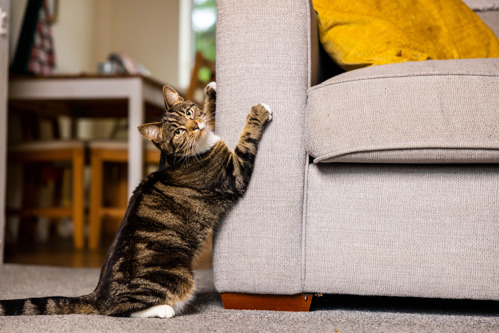Think your cat is being naughty? Think again.
From scratching the furniture and climbing the curtains, to clawing your hands or waking you up in the early hours. If your cat is causing chaos at home, you might think they’re being deliberately mischievous.
But what you might think of as ‘naughty’ behaviour is probably just your cat being a cat. Clinical Animal Behaviourist Daniel Warren-Cummings explains the causes of ‘mischievous’ cat behaviour, and how understanding your cat better can help keep harmony at home.

Why is my cat so naughty?
When we call a cat ‘naughty’, we usually mean they are doing something we don’t like. But what we consider naughty can vary from person to person.
Calling a cat naughty implies they know the rules and are choosing to break them. But that’s a very human way of thinking. Cats don’t understand what is naughty and what isn’t. They are just being a cat.
Typically, ‘naughty’ cat behaviour is either:
- a normal cat behaviour that humans don’t like
- a sign that something is wrong
It’s important not to punish your cat for these behaviours. They won’t understand what they’ve done wrong. Punishing them will likely only make the problem worse.
Instead of seeing your cat as ‘naughty’, try to understand the reason for their behaviour. You may be able to provide them with an alternative outlet that you are both happy with. Or perhaps there is a medical cause that needs to be treated by your vet.
Normal cat behaviours we consider ‘naughty’
Many cat behaviours we see as ‘naughty’ are perfectly normal for cats. Here are a few of these natural behaviours and what you can do about them.
- Jumping on counters. Cats love being up high. It’s how they stay safe and scope out their surroundings. If your kitchen counters are the only elevated surfaces around, they’re going to climb them.
What you can do: Try providing them with an alternative, such as empty shelves or a cat tree. - Scratching furniture. Cats need to scratch to keep their claws healthy. It also leaves behind a scent that is excreted from between their toes, letting them know this place is familiar and safe. Unfortunately, sofas and carpets are great for digging their claws into.
What you can do: Find out how to prevent your cat from damaging your furnishings in our video: - Knocking things off tables. Cats are naturally curious and often like to investigate unfamiliar objects with their paws. This may result in items being knocked over from time to time.
What you can do: Try to avoid leaving breakable objects on the edge of surfaces that your cat can reach. - Climbing curtains. Cats climb because they love to get up high and view their surroundings.
What you can do: Give them a safe alternative, like a tall cat tree or empty shelf. - Bringing home dead animals. Cats are natural predators. They’re simply following their instincts when they catch small animals they find outside. It might seem gruesome, but they bring their prey back to the house because it is their core territory. They know it will be safe from being stolen by other wildlife. They don’t hunt because they’re being cruel or even because they’re hungry. They do it because pouncing and catching things makes them feel happy.
What you can do: Find out how to stop cats from bringing in dead animals. - Attacking hands and feet. Cats respond to movement. Wiggling fingers and toes are irresistible, especially if they’ve been encouraged to play this way as kittens.
What you can do: To keep your hands and feet safe, watch our video to see how you can encourage safe play sessions instead: - Digging up the flowerbeds. Loose soil is the perfect toilet for your cat. Your cat doesn’t know it’s where you grow your prize-winning blooms, they just know it’s soft, absorbent and diggable.
What you can do: Find out how to stop your cat pooing in your garden. - Waking you up at night. While we may appreciate a lie-in, cats are typically early risers. They’re naturally most active at dawn and dusk. Sadly, this can often mean that instead of leaving us to remain cosy under the duvet, they urgently need our attention as soon as the sun comes up.
What you can do: Watch our video for tips on how to keep your moggy alarm from going off quite so early:
‘Naughty’ cat behaviours that show something is wrong
Sometimes ‘mischievous’ cat behaviours can be a sign of stress, pain or discomfort. Here are some of these unusual behaviours and what you can do about them.
- Biting or aggression. It’s not common for cats to be aggressive. This is usually a sign that they are scared or in pain.
What you can do: Find out more about dealing with aggressive cats. - Toileting outside the litter tray. Cats don’t pee or poo around the house to be naughty. It could be a sign that they are in pain, or that their litter tray isn’t suitable for them.
What you can do: Find out how to stop your cat toileting around the house.
Why is my cat suddenly misbehaving?
If you notice any sudden change in your cat’s behaviour, get them checked by your vet. There could be an underlying medical issue causing the behaviour. If your vet says your cat is healthy, there will be another cause for their behaviour. Read our advice above to work out what to do.
Why does my cat act crazy all of a sudden?
If your cat gets a sudden burst of energy and starts running around the house, this is commonly known as ‘zoomies’. Occasional zoomies are quite normal for cats. But if your cat is getting the zoomies on a daily basis, this could be a sign that they are under-stimulated and frustrated. Find out how to prevent cat zoomies.

Why is my cat naughty at night?
If your cat is displaying unwanted behaviours at night, they could be bored or frustrated. If they didn’t get enough stimulation throughout the day, they may have excess energy to burn off while you’re asleep. Find out how to help a bored cat.
Do cats go through a naughty phase?
Cats can display behaviours we might consider ‘naughty’ at any age. Young kittens often have a reputation for being more ‘naughty’ or ‘rebellious’ than older cats. But this is usually because they have lots of energy. Kittens need lots of opportunities to play, explore and interact with their owners. This helps prevent them from getting bored or frustrated.
Cats do go through a ‘teenage’ phase, typically around the time they reach puberty. This occurs when they are between four to 12 months old, depending on the cat. During this time, their behaviour can shift as they navigate the transition from kittenhood to adulthood. Find out more about your cat’s teenage phase.
Learn to understand your cat’s needs with our online learning courses.



